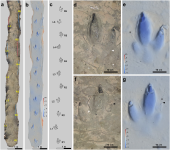Fred Ruhe
Well-known member

Ricardo o N. Melchor, Silverio F. Feola,, M. Cristina Cardonatto, Nahuël Espinoza, Manuel A. Rojas-Manriquez & Lorena Herazo, 2023
First terror bird footprints reveal functionally didactyl posture
Scientific Reports First terror bird footprints reveal functionally didactyl posture - Scientific Reports
Abstract
Terror birds (Aves, Phorusrhacidae) comprise the most outstanding group of South American Cenozoic avifauna, and have been considered dominant predators. Terrestrial habits were inferred using the reduction of their forelimbs and high body mass. Phorusrhacids were considered functionally tridactyl with three relatively short digits II–IV and a small, elevated digit I. The function of the ungual phalanges of digit II have been debated, including the utility of the ungual for retention or stabbing of prey. Incomplete or lack of preservation of foot bones have hampered understanding of the evolution and diversification of Phorusrhacidae. Here we show the first known and well-preserved footprints of Phorusrhacidae with a didactyl posture, which are named Rionegrina pozosaladensis igen. et isp. nov. These footprints yield unprecedented information on the locomotor habits of the group. The finding implies that medium-sized, Late Miocene (~ 8 Ma) phorusrhacids developed strong cursorial adaptations; achieved through reduction of digit II, raised metatarso-phalangeal pad, main body support in a large and thick digit III, and digit IV as outrigger. Raised and long claw of digit II was probably used in pining of prey. Phorusrhacid footprints differ from the Early Cretaceous didactyl footprints of deinonychosaurian dinosaur affinity by its larger size and strong mesaxony.
Enjoy,
Fred
First terror bird footprints reveal functionally didactyl posture
Scientific Reports First terror bird footprints reveal functionally didactyl posture - Scientific Reports
Abstract
Terror birds (Aves, Phorusrhacidae) comprise the most outstanding group of South American Cenozoic avifauna, and have been considered dominant predators. Terrestrial habits were inferred using the reduction of their forelimbs and high body mass. Phorusrhacids were considered functionally tridactyl with three relatively short digits II–IV and a small, elevated digit I. The function of the ungual phalanges of digit II have been debated, including the utility of the ungual for retention or stabbing of prey. Incomplete or lack of preservation of foot bones have hampered understanding of the evolution and diversification of Phorusrhacidae. Here we show the first known and well-preserved footprints of Phorusrhacidae with a didactyl posture, which are named Rionegrina pozosaladensis igen. et isp. nov. These footprints yield unprecedented information on the locomotor habits of the group. The finding implies that medium-sized, Late Miocene (~ 8 Ma) phorusrhacids developed strong cursorial adaptations; achieved through reduction of digit II, raised metatarso-phalangeal pad, main body support in a large and thick digit III, and digit IV as outrigger. Raised and long claw of digit II was probably used in pining of prey. Phorusrhacid footprints differ from the Early Cretaceous didactyl footprints of deinonychosaurian dinosaur affinity by its larger size and strong mesaxony.
Enjoy,
Fred





